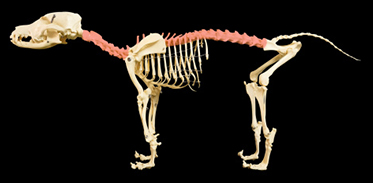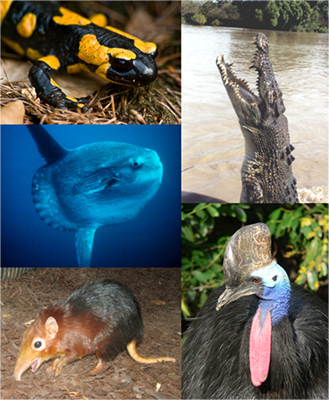Have you even seen a house that is in the process of being built? The first thing that comes together is the house's frame. A strong house frame is essential for a sturdy house, one that will stand upright for a lifetime. Your body's skeleton is a little like a house's frame in that it helps you to stand upright. The structure that specifically helps you to stand upright is your spine, or vertebral column. You share this structure with animals like fish, amphibians, birds, and reptiles. These groups of animals, along with mammals like you, are vertebrates, or animals that have backbones.
 The backbone (also called a spine or vertebral column) in this dog skeleton makes the dog part of a group of animals called vertebrates. |
Although these animals certainly look very different, they all share several characteristics. Roll your cursor over each row in the table to explore just four of the many characteristics of vertebrates.
 Fish, amphibians, reptiles, birds, and mammals all share common characteristics because they are all vertebrates. |
| Bilateral symmetry | All vertebrates have bilateral symmetry. This type of symmetry means that the left and right halves of the animal are mirror images of one another. |
| Pairs of appendages | All vertebrates have appendages--limbs, fins, or wings--in pairs. |
| Central nervous system | All vertebrates have a true brain and a spinal cord that is surrounded by a skull and a spinal column. |
| Endoskeleton | All vertebrates have a skeleton inside the body that is made of cartilage or bone, as opposed to a skeleton outside the body (exoskeleton). |
You might notice that all of these characteristics relate to structures that provide shape, support, or protection for an organism. Providing shape and support is a major function of the skeletal system in vertebrates.
Question
What might be an advantage to having an endoskeleton instead of an exoskeleton?
